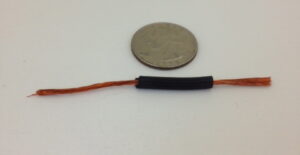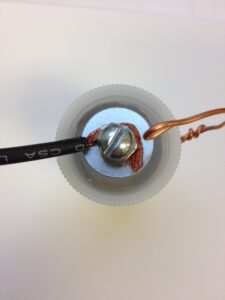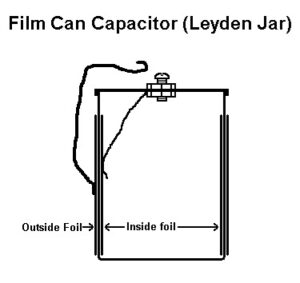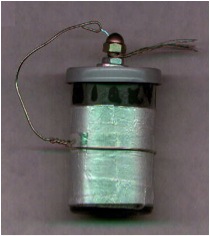 by: Norm Barstow
by: Norm Barstow
This is a guide on how to make a Leyden Jar that makes awesome sparks with materials you may even find in your house. It’s inexpensive, basically harmless and fun.
Here is the list of materials you will need:
- An empty film canister with lid. These are available at Educational Innovations.
- Multistrand insulated wire; eg. type HPN Heater Cord
- Single conductor/solid un-insulated wire, about 1.5 mm in diameter (16 gauge copper wire).
- Some aluminum or copper foil. (NOTE: Any conductive foil will work. Copper foil is thicker and easier to work with than aluminum foil, but aluminum foil works. Heavy duty aluminum foil works best.
- A bolt (10/24) with a round head that is shorter than the film canister’s height. Two nuts that fit the screw. Washer is optional.
- Scotch tape.
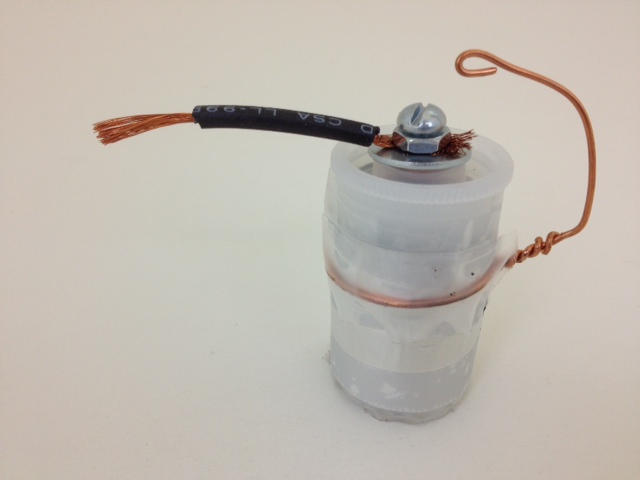
Now that you have all the parts, get to work. See the diagrams below to guide you.
1. Drill a hole or poke a hole in the lid of the film canister. The hole should be just wide enough to let the bolt fit snugly inside it.
2. Next, cut a rectangle of foil large enough to wrap around the outside of the film canister and about 2/3 of the height of the canister.
3. Tape the foil to the canister, being sure to leave an open section for the loop of wire that will go around the canister over the foil. (You should just need to tape the edges of the foil to the outside of the canister.) DO NOT USE Rubber cement. It is highly flammable and explosive and could be set off by sparking inside.
4. Cut another piece of foil (same size) and fasten it to the inside of the canister. If you are using heavy duty foil, you shouldn’t have to use tape. The tension of the foil being rolled up should be enough to keep it plastered to the inside of the canister. If you use normal foil, you’ll have to tape the edges. It is very important that the foil touches the container all the way around the inside of the canister.
5. Cut the multistrand wire: It should be about 1″ (2 cm) long and have .25″ or (.75 cm) of insulation stripped off the outside of both ends.
6. Next, using the bolt and nut, secure the multistrand wire to the top of the lid. Form one end of the multi strand wire in a hook shape to fit the bolt.
7. Fan/spread out the conductors on the other end of the multistrand wire.
8. Secure the solid wire to the underside of the lid, making a loop at the end so that it won’t tear the foil. Then bend the wire so that it will touch the inside of the canister.
9. Place the lid on the canister, ensuring that the wire loop touches the foil on the inside. Adjust if necessary.
10. Last, wrap a piece of the solid wire around the outside the canister, twist tight and then continue in slight curve up toward the bolt. Shape the end near the bolt into a small circle. MAKE SURE that the top of the wire is at a MAXIMUM of ¼” away from the bolt.
11. After the copper wire is in position, cover the wire with scotch tape or electrical tape so you don’t shock yourself while handling it.
What you’ve built is a very simple capacitor. To use it, simply wave the canister over the surface of CRT TV screen or monitor, or anything that makes static electricity (the multistrand wire ‘receives’ the static electricity and therefore must be closest to the static source.)
Then gently push down the end of the outside solid wire so it reaches a little closer to the bolt head, without touching and ZAP! There’s your spark.
SAFETY
Most of the time, the jar will discharge itself with no extra help. Please note that the finished jar holds high voltage, low current electricity, which is normally harmless. However, don’t take any chances! If you’re not sure if it’s charged or not and you think it’s not safe. Simply press on the outside of the wire against the bolt to completely discharge it. Keep your finger away from the bolt head area as much as possible while it is charged. You don’t want an ‘accident’ (you’ll just get a static shock. No one likes getting a static shock.
If you’re having trouble charging the jar (CRT TV or monitor), follow the directions for building a Static Electricity Generator.
Static Electricity Generator with PVC Pipe
- Materials:
- A PVC pipe, ¾“ wide and about 3-4′ long.
- Fur, wool, or cotton fabric.
To operate:
- Take the fabric and rub it along the pipe all the way up, and then all the way down.
- Have someone else hold the jar; pressing the multistrand pickup wires to the pipe, and then discharge the jar after a few seconds of rubbing.
Check out another great Blog on Leyden Jars.
